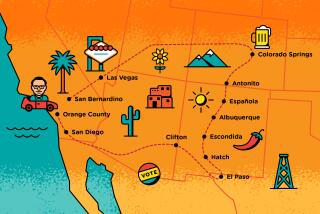Lessons in Mobility From Mexico
- Share via
With the five-year fight between the Bus Riders Union and the Metropolitan Transportation Authority for additional buses again in the news, I cannot but reflect on how a “poor, backward” country like Mexico has come to achieve what is impossible in the San Fernando Valley: a transportation system for the masses.
In Mexico City, the government subsidizes all public transportation. Folks ride the Metro for a pittance. During the 1985 earthquake, it was considered the safest place in the city. Buses run every 5 to 10 minutes from most areas. Taxis (refurbished Volkswagens) are dirt cheap; even college students ride them. The half-hour ride to the airport costs less than $15. In sum, trabajadores--workers--few of whom own cars, are assured of getting to work. Regardless.
As the bus I’m on cuts through the crowded Mexico City streets, I cannot but pity the Latino bus riders back home who stand for hours at low-paying jobs, then must once more stand inside a hot, stuffy bus. And pity the homemaker who takes the bus to el mercado, the market, and then, laden with grocery bags, struggles for a seat. But most of all, pity the sickly folks who take two to three buses to the hospital for chemotherapy, then must wait hours for a bus while trying not to pass out.
Having had access to a car for most of my life, I’ve rarely taken the bus, which is fortunate because for eons, bus service in Sunland-Tujunga was almost nonexistent.
My one experience was in the 1980s when, as a graduate student at UCLA, I rode Line 88 from the then-Pacoima Memorial Hospital parking lot to campus. A student pass cost $10 a month.
At first I enjoyed the 40-minute ride, but by afternoon, folks got pushy. Forced to stand, I juggled purse and book bag as tired maids from Bel-Air grasped bus straps to keep from falling. By the time we hit Sherman Way, most office workers were gone; rowdy students now filled the aisles. At Van Nuys Boulevard in Pacoima, the overloaded bus no longer stopped. As we flew by, folks waiting at the bus stop looked at us with envy.
When in Mexico City, much to the concern of my hosts, I take the Metro to el Zocalo, the city’s hub. The handicapped get to ride free, in designated seats near the doors. On weekends, folks in their Sunday best ride to Bellas Artes, Mexico’s Carnegie Hall, home to the Mexican Symphony. But the most crowded Metro line is the one going to the Basilica of Our Lady of Guadalupe, where pilgrims from small villages pray, light candles and offer flowers to la virgen, the virgin.
I knew I was back in California when at Los Angeles International Airport, the only Flyaway bus, a shuttle out of Van Nuys Airport, screeched to a stop and the harassed driver announced that he could only take on five passengers. Faster than a speeding bullet, I pushed my way to the front and jumped aboard. I dared not grumble at having to stand, grateful to be on the inside, even more so when at the next stop, the driver again refused passengers. Amid jeers (and some threats), he yelled: “Another bus is on its way.” Liar, Liar! When we finally took off, everyone in the bus cheered.
While the MTA and the City Council squabble over which district most needs mass transportation, folks in the San Fernando Valley wait. And wait. I ask you: Is there a lesson to be learned from a “poor, undeveloped” country?
More to Read
Sign up for Essential California
The most important California stories and recommendations in your inbox every morning.
You may occasionally receive promotional content from the Los Angeles Times.













